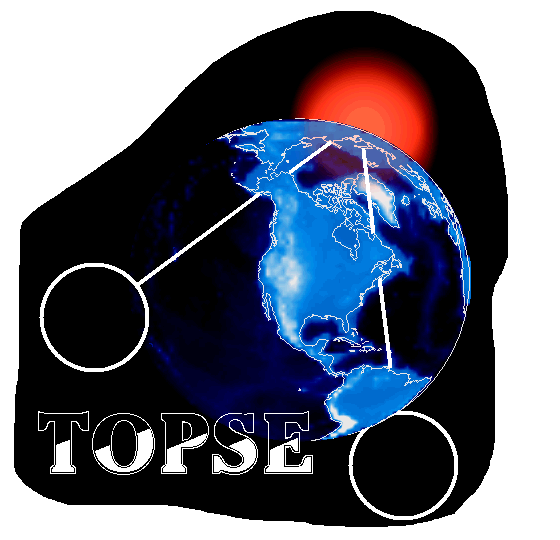TOPSE
The Tropospheric Ozone Production about the Spring Equinox

The experiment took place from Feb-May, 2000
It consisted of a series of 7 round trip missions from Colorado to northern latitudes, using the NCAR C-130 flying laboratory. The TOPSE experiment covered a latitude range from 40 N to near the North Pole, and from 100 ft to 25,000 ft. in altitude. The experimental design used in-situ and remote sensing observations to evaluate the rapid onset and early stages of active photochemistry in the Northern Hemisphere. These observations provided a unique characterization of the temporal and spatial distribution of ozone and ozone precursors over continental North America, and, more importantly, a better understanding of the primary photochemical and dynamic processes that control the budgets of radicals and reservoirs in the free troposphere. Measurements of ozone chemistry in the Arctic boundary layer provided important new data to document ozone loss processes near the surface. Furthermore, through appropriate comparisons of measurements and model predictions, the TOPSE experiment is providing important tests and constraints of photochemical models that will advance the development of global and regional simulations of tropospheric ozone.
Background to the experiment
One of the major research emphases in atmospheric chemistry continues tothe study of the photochemical and dynamic processes that determine the rates of formation and loss of oxidants throughout the atmosphere. Oxidation processes shape the chemical composition of the atmosphere through transformations that act on the large variety of trace gases emitted from natural and anthropogenic sources. Since these processes affect the distribution and trends of radiatively important trace gases in the atmosphere, there is a potential feedback between chemistry and climate that has implications for future global change.
Tropospheric ozone plays a central role in the oxidative chemistry of the troposphere, has an important impact on the radiative balance of the atmosphere, and is known to have detrimental effects on human health and agricultural crop production. For these reasons, understanding the processes that control the origin, trends, distribution, and effects of tropospheric ozone have been high priority themes to atmospheric chemistry research over the last few decades.
The processes that control the concentrations and distribution of tropospheric ozone are a complex interplay of chemistry and dynamics. The sources, transformations, and interactions of radical and reservoir species in the HOx, NOx, and organic carbon families, as well as ozone itself, play a role in determining local rates of ozone production and loss. In addition to strictly chemical and photochemical processes, ozone distributions are affected at least as significantly by atmospheric dynamics. Ozone distributions are affected by direct advective transport of ozone and reactive precursors through the troposphere, by stratosphere/troposphere exchange, and through convective processes which rapidly transport ozone and precursors to different environments of radiation, temperature, humidity, aerosol loading, etc.
A feature of tropospheric ozone that is thought to have significant contributions from both chemical and dynamic origins is the widely observed springtime maximum of ozone in the Northern Hemisphere mid latitudes. The origin of this maximum has been attributed to increased input of ozone from the stratosphere to the troposphere, but it has also been suggested that tropospheric photochemical processes may also play a significant role in producing the maximum.

Experimental Design
The TOPSE investigation combined model studies and simulations with a set of chemical and photochemical measurements taken over the critical winter-spring transition in the northern mid-to-high latitude troposphere. The overall goal of the experiment was to investigate the chemical and dynamic evolution of tropospheric chemical composition over mid- to high-latitude continental North America during the winter/spring transition; a particular emphasis was placed on the springtime ozone maximum in the troposphere. As the experiment progressed additional effort was used to investigate dramatic ozone depletion events found over large regions of the Arctic surface layer.
